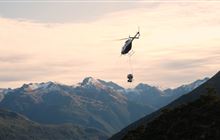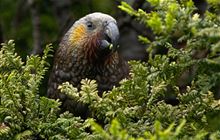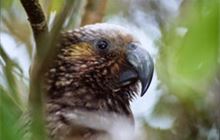1080 and drinking water
Introduction
1080 operations have never contaminated drinking water in New Zealand. There are regulations and practices to prevent this from happening.Research into 1080 and water
There is no evidence that drinking water has ever been contaminated with 1080. Research and monitoring in water catchments treated with 1080 have shown that contamination is extremely unlikely when safety procedures are followed.
To ensure that our drinking water is always safe, the Ministry of Health has set a strict guideline that 1080 can only be present at levels below 2 parts per billion (ppb). This is the equivalent of about three pin heads on a football field.
At these levels, an adult weighing 70 kg would have to drink 70,000 litres (or 230 baths full) of contaminated water in one go to receive a fatal dose. No tests of drinking water after 1080 operations have come close to this limit.
More than 2000 samples of water used for human drinking supplies were tested between 1990 and 2023. Of these, only four contained traces of 1080 at concentrations of 0.1 to 0.2 ppb. These are extremely low levels that are well below the Ministry of Health requirement. They posed no risk to human health.
Safeguards
Every aerial 1080 operation is strictly controlled and must be approved by a medical officer of health or health protection officer before it can go ahead. This approval can include conditions on the use of 1080.
Conditions can include:
- excluding particular areas to protect drinking water supplies
- requiring bait-free buffer zones around larger streams
- water monitoring after the operation.
If water monitoring is required, samples are collected 12-24 hours after an operation, since this is the time when any of the toxin is most likely to be found. Samples are collected by local or regional councils at sites chosen by a local public health officer. The sampling sites are deliberately chosen to detect any 1080 that has entered the water supply area.
As an extra safeguard, water intakes in an area are often shut down before a 1080 operation until tests confirm the water is completely safe to drink.
Water testing
In New Zealand, water is tested for 1080 by Manaaki Whenua Landcare Research, This is is an independent crown research institute that uses robust scientific methods.
Private water supplies
Private water supplies, like streams or rainwater tanks, are identified as part of the planning for every 1080 operation. The Ministry of Health determines the appropriate measures to keep these private water supplies safe.
Streams and rivers
During predator control operations, 1080 from uneaten bait pellets can get into streams and rivers through runoff or directly from baits falling into streams. Research shows there’s a very low risk of contamination.
1080 dissolves to harmless levels very quickly when exposed to water and is almost always undetectable in waterways after 24 hours.
Public health requirements and operational practices ensure that the use of 1080 does not have a negative impact on the water quality of streams or rivers.
However, people are advised to be cautious when drinking from open waterways because there may be other contaminants present.
Tramping huts
Exclusions and checks are used so that 1080 does not reach water tanks in back-country huts. We close water supplies to huts in operational areas until any risk of 1080 being present has passed.
Explore Why we use 1080 to learn more about how 1080 naturally breaks down in the environment.
References
- Water safety after a 1080 drop (NIWA)
- Protocols for water testing (Landcare research)
- Issuing Permissions for Vertebrate Toxic Agents (VTAs): Guidelines for Public Health Units (Ministry of Health)
- Human exposure to fluoroacetate in tea and edible plants – could it exceed acceptable intake limits? (Landcare Research)




